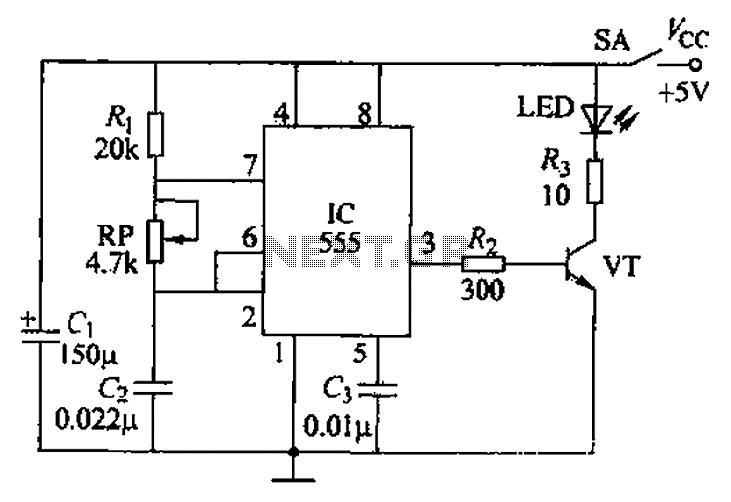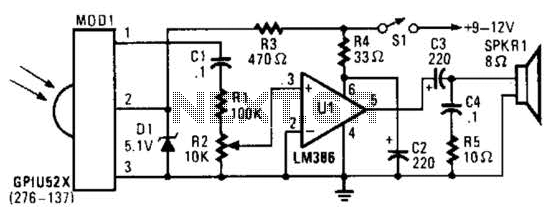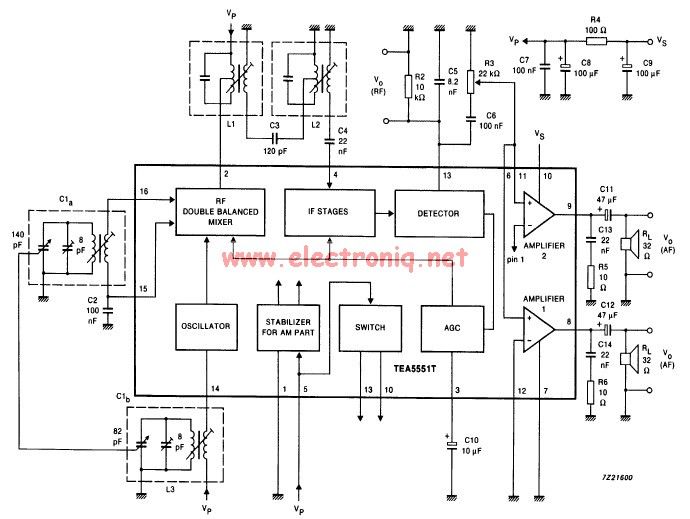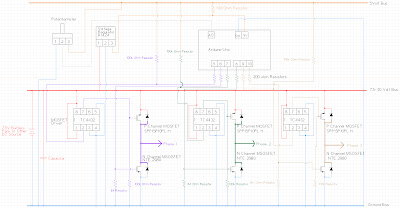
555 Pulse Generator
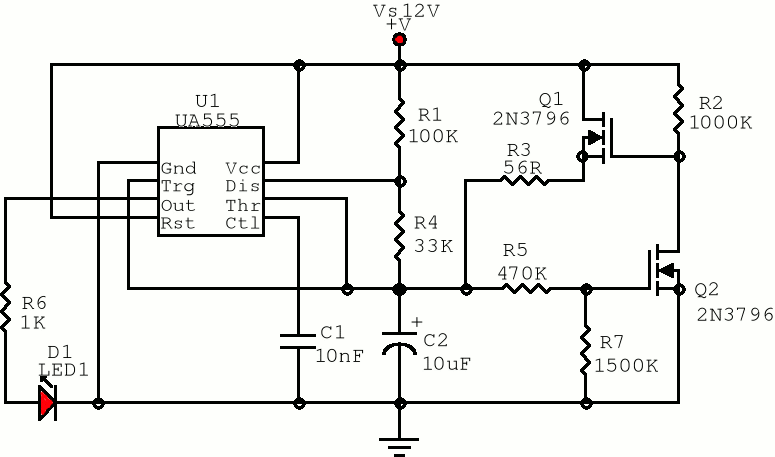
The first positive pulse from a classic 555-based oscillator is always 1.6 times longer than the subsequent pulses. This discrepancy arises because, during the initial cycle, capacitor C2 begins charging from 0 V. While this is typically not an issue, there are instances where the first pulse should ideally match the length of the following pulses, at least approximately. The accompanying illustration depicts the oscillator with an additional component (everything to the right of the Vs-Gnd axis) designed to address this problem. Upon power-up, C2 is discharged, resulting in a low voltage at the gate of transistor Q2. Consequently, Q2 remains off, allowing C2 to charge rapidly through transistor Q1 and resistor R3 until it reaches just below Vs/3. At this point, Q2 activates, Q1 deactivates, and the standard circuit operation resumes, with C2 charging and discharging relatively slowly between 2Vs/3 and Vs/3. Since the voltage across C2 does not fall below Vs/3 again, Q2 remains in a conducting state, and Q1 stays off permanently. The values of the components are critical; for optimal performance, the voltage divider formed by R5 and R7 should turn on Q2 when C2 is charged to slightly below Vs/3. This activation point is determined by the ratio of R5 to R7. However, if R5 is excessively high or R7 is too low (in relation to the supply voltage and the gate-source threshold voltage of Q2), the oscillator may fail to operate. The combined resistance of R5 and R7 should be maximized to reduce any impact on the main circuit after the initial pulse.
The described circuit utilizes a 555 timer in astable mode, which is known for generating a continuous square wave output. The addition of components to modify the behavior of the first pulse is essential for applications where pulse width uniformity is critical. The capacitor C2 plays a pivotal role in timing; its charging rate is influenced by the resistors R3 and the configuration of Q1 and Q2.
Transistor Q1 is responsible for facilitating the rapid charging of C2, while Q2 acts as a switch that controls the discharge path of the capacitor. The voltage divider formed by R5 and R7 is strategically placed to ensure that Q2 turns on at the correct voltage level, which is crucial for maintaining the desired pulse width. The choice of resistor values must consider the specific characteristics of Q2, particularly its gate-source threshold voltage, to ensure reliable operation under varying supply voltages.
In summary, this circuit modification effectively synchronizes the first pulse with subsequent pulses by leveraging the charging characteristics of C2 and the switching behavior of Q1 and Q2. Proper selection of component values is critical to achieving the desired performance, ensuring that the oscillator operates reliably in applications requiring precise timing sequences.The first positive pulse from a classic 555-based oscillator is always 1. 6 times longer than the following pulses. The difference is caused by the fact that only during the first cycle C2 starts charging up from 0 V. This is generally not a problem, but sometimes this first pulse just should be the same length as the rest - at least approximately.
The picture shows the oscillator and an addition to it (everything to the right from the Vs-Gnd axis) that can solve the problem. Immediately after switch-on, C2 is empty and the voltage on the gate of Q2 is low. Q2 is off and it makes C2 charge up very quickly through Q1 and R3 until it reaches just below Vs/3. Then Q2 turns on, Q1 turns off, and the classic circuit continues to charge and discharge C2 relatively slowly between 2Vs/3 and Vs/3.
As the voltage on C2 never again drops below Vs/3, Q2 now conducts all the time and Q1 is permanently off. The component values may be critical. For best results, the R5/R7 voltage divider should turn Q2 on when C2 is charged up to just a little below Vs/3.
This point is set by the R5/R7 ratio. But if the value of R5 is too high or if R7 is too small (depending on the supply voltage and the G-S threshold voltage of Q2), the oscillator may not work at all. The sum of R5 and R7 should be as high as possible in order to minimize the influence on the main part of the circuit after the first pulse.
🔗 External reference
The described circuit utilizes a 555 timer in astable mode, which is known for generating a continuous square wave output. The addition of components to modify the behavior of the first pulse is essential for applications where pulse width uniformity is critical. The capacitor C2 plays a pivotal role in timing; its charging rate is influenced by the resistors R3 and the configuration of Q1 and Q2.
Transistor Q1 is responsible for facilitating the rapid charging of C2, while Q2 acts as a switch that controls the discharge path of the capacitor. The voltage divider formed by R5 and R7 is strategically placed to ensure that Q2 turns on at the correct voltage level, which is crucial for maintaining the desired pulse width. The choice of resistor values must consider the specific characteristics of Q2, particularly its gate-source threshold voltage, to ensure reliable operation under varying supply voltages.
In summary, this circuit modification effectively synchronizes the first pulse with subsequent pulses by leveraging the charging characteristics of C2 and the switching behavior of Q1 and Q2. Proper selection of component values is critical to achieving the desired performance, ensuring that the oscillator operates reliably in applications requiring precise timing sequences.The first positive pulse from a classic 555-based oscillator is always 1. 6 times longer than the following pulses. The difference is caused by the fact that only during the first cycle C2 starts charging up from 0 V. This is generally not a problem, but sometimes this first pulse just should be the same length as the rest - at least approximately.
The picture shows the oscillator and an addition to it (everything to the right from the Vs-Gnd axis) that can solve the problem. Immediately after switch-on, C2 is empty and the voltage on the gate of Q2 is low. Q2 is off and it makes C2 charge up very quickly through Q1 and R3 until it reaches just below Vs/3. Then Q2 turns on, Q1 turns off, and the classic circuit continues to charge and discharge C2 relatively slowly between 2Vs/3 and Vs/3.
As the voltage on C2 never again drops below Vs/3, Q2 now conducts all the time and Q1 is permanently off. The component values may be critical. For best results, the R5/R7 voltage divider should turn Q2 on when C2 is charged up to just a little below Vs/3.
This point is set by the R5/R7 ratio. But if the value of R5 is too high or if R7 is too small (depending on the supply voltage and the G-S threshold voltage of Q2), the oscillator may not work at all. The sum of R5 and R7 should be as high as possible in order to minimize the influence on the main part of the circuit after the first pulse.
🔗 External reference
Warning: include(partials/cookie-banner.php): Failed to open stream: Permission denied in /var/www/html/nextgr/view-circuit.php on line 713
Warning: include(): Failed opening 'partials/cookie-banner.php' for inclusion (include_path='.:/usr/share/php') in /var/www/html/nextgr/view-circuit.php on line 713
